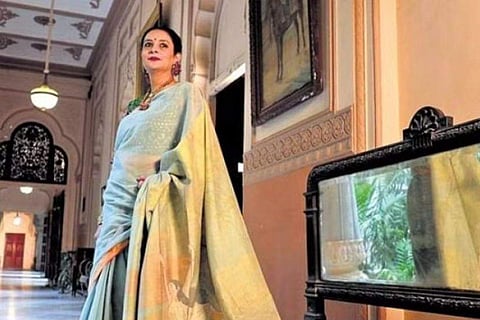
- LIFESTYLE
- FASHION
- FOOD
- ENTERTAINMENT
- EVENTS
- CULTURE
- VIDEOS
- WEB STORIES
- GALLERIES
- GADGETS
- CAR & BIKE
- SOCIETY
- TRAVEL
- NORTH EAST
- INDULGE CONNECT

India is rich with craftspeople doing amazing work—quietly. I wanted to bring them into the limelight,” says textiles revivalist and conservationist Lavina Baldota, on the sidelines of the exhibition, Sutr Santati:
Then, Now, Next, which uses a range of fabrics and embroidery techniques. There’s Vinay Narkar’s mulberry silk dupatta with Maratha-period miniature art handwoven into it; or an exquisite panel by Aruna Malani, which uses petit point embroidery to interpret the tree of life design, historically popularised by chintz. Another eye-catching exhibit—Baldota explains it thus: “textile as art and art as textile”—is the Infinite Fields installation conceived by Moonray Craft Collective as an ode to the joys of childhood. Set against rolling wheat fields crafted from date palm raffia, the pastoral landscape is brought to life through traditional toy-making techniques and repurposing scrap fabrics. Perhaps the most poignant is Constitutional Courage, an indigo-dyed khadi panel by Aditya Shrimali depicting the Preamble to the Constitution in Braille—rendered in tangaliya weaving.
Comprising 125 pieces by nearly 200 designers, the show, presented by Abheraj Baldota Foundation, is ongoing at the NGMA, Mumbai. Every piece is accompanied by a placard that not only mentions the designer and technique used, but also names all the karigars involved in its making. In fact, curator Baldota returned several pieces where the designers couldn’t (or wouldn’t) acknowledge the artisans. It its third iteration, as many as 75 works are new to this edition. For instance, Kailash Nath Lodhi’s intricate panel of ek taar (single-thread) chikankari depicts a forest complete with leopards slinking about. Lucknow-based Lodhi says it took him and his artisans 1.5 months to complete the handkerchief-sized panel. Returning contributors like architect Ashiesh Shah have new pieces in this edition. His vermillion-coloured Ganesh panel combines Channapatna beads with moli (sacred thread traditionally tied around the wrist).
Sutr Santati (meaning ‘the continuation of the thread’) is divided into five themes. In the ‘Nationalistic Themes’ section, a large-scale wall panel by Chanakya School of Craft features the image of Mahatma Gandhi. The use of varied embroidery stitches, hand-couching, knotting and fine zardozi all blending together is meant as a metaphor for India’s unity in diversity. ‘The Sacred’ section highlights the return of religious themes. Case in point is the Ganesha wall panel by Odisha-based artisan, Arjun Meher, with 21 forms of the deity in Sambalpuri ikat. The technique involves tie-dyeing the warp and weft before weaving. The ‘Indigenous Expressions’ section includes a Muga silk sari by Chandrani Baruah, lustrous with the natural golden hue of the GI-protected silk from Assam; and a panel designed by Veena Upadhyay interprets the 300-year-old Bihari baavan buti (52 motifs) tradition of hand-weaving.
Some pieces stun with the scale of their ambition like the handwoven wall panel by Gaurang Shah, recreating in jamdani Raja Ravi Varma’s Sita Bhumi Pravesh. It is compelling for its level of detailing.
“I want to create awareness, especially among the younger generation. That’s why my exhibitions are never going to be in a gallery, but in museums, which give access to everybody,” says Baldota.